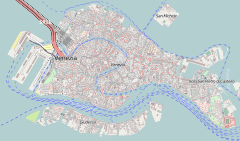Sant'Elena, Venice
| Sant'Elena | |
|---|---|
_Facade.jpg) Facade of Sant'Elena | |
 Shown within Venice  Sant'Elena, Venice (Italy) | |
| Basic information | |
| Location | Venice, Italy |
| Geographic coordinates | 45°25′38.39″N 12°21′56.32″E / 45.4273306°N 12.3656444°ECoordinates: 45°25′38.39″N 12°21′56.32″E / 45.4273306°N 12.3656444°E |
| Affiliation | Roman Catholic |
| Province | Venice |
| Architectural description | |
| Architectural style | Gothic |
| Completed | 1028 |
Sant'Elena, also sometimes called Santa Lena, is a Gothic-style, Roman Catholic church at the extreme east end of the sestiere of Castello in the City of Venice, Italy.
_Apse_and_tower.jpg)
History
This site was once the island of Sant'Elena, once not accessible on foot from the city, but now representing the east end of Venice. The first chapel here was built by Augustinian monks in 1028 and dedicated to Empress Saint Helena. By 1175, they had built here a convent and hospital.[1] In 1211, the body of St. Helena was putatively transported to Venice from Constantinople by the monk Aicardo from this monastery. They added a chapel for her relics to the church. In 1407, the convent had fallen to ruin, and the complex was affiliated with the Olivetani order.[2] In 1810, the church was deconsecrated under Napoleonic rule.
The urn putatively containing St Helen's remains was putatively hidden in the Basilica of San Pietro in Castello,[3] and the Renaissance portal of the church was transferred to the church of Sant'Aponal.
Sant'Elena was reconsecrated in 1928 and granted to the Servite Order. The urn of St. Helena was returned; the bell tower was rebuilt; and the original portal replaced. The main altarpiece, depicting the Adoration of the Magi with St. Helena, which had been relocated during the Napoleonic era still remains in the Pinacoteca di Brera.
Description

The mullioned windows and rose window in the brick façade are Gothic in style. Above the portal is the Renaissance style Monument to Vettore Capello (1467), where Capello, a Venetian admiral, is kneeling before the Saint; the sculptor was Niccolò di Giovanni of Florence.[4]
The original bell-tower, built in 1558, had been razed in the early 19th-century. The main altarpiece is a copy of that found in the Church of Sette Santi Fondatori in Florence. The interior is mostly bare; most of the paintings are now in the Gallerie dell'Accademia.
Of the adjacent Convent, only part of the cloister and the central well head remain. The buildings now house a foundation dedicated to world peace.
_Side_chapel.jpg) Chapel of St. Helena, mother of Constantine the Great
Chapel of St. Helena, mother of Constantine the Great_Interior.jpg) Inside the nave and choir
Inside the nave and choir_Altarpiece.jpg) Altarpiece
Altarpiece_Ceiling_of_the_nave_and_choir.jpg) Ceilings of the nave and choir.
Ceilings of the nave and choir._Cloister.jpg) Cloister
Cloister
Notes
- ↑ Notizie storiche delle Chiese e Monasteri di Venezia e di Torcello, by Flaminius Corner, page 64.
- ↑ Corner, page 66.
- ↑ Fodor's Venice and the Venetian Arc, page 61.
- ↑ Venetian Heritage projects.
References
- Marcello Brusegan, Le chiese di Venezia, Ed. Newton&Compton
- Giulio Lorenzetti, Venezia e il suo estuario, Ed. Lint Trieste
External links
| Wikimedia Commons has media related to Sant'Elena, Venice. |